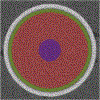Soft tissue variations influence HR-pQCT density measurements in a spatially dependent manner
- PMID: 32599223
- PMCID: PMC7428203
- DOI: 10.1016/j.bone.2020.115505
Soft tissue variations influence HR-pQCT density measurements in a spatially dependent manner
Abstract
Objective: Significant weight loss following treatments for obesity undermines bone metabolism and increases bone turnover and fracture incidence. High resolution peripheral quantitative computed tomography (HR-pQCT) is widely used in skeletal heath assessment research to provide noninvasive bone parameter measurement (e.g. volumetric bone mineral density (vBMD)) with minimal radiation exposure. However, variation in body composition among study groups or longitudinal variations within individuals undergoing significant weight change will generate artifacts and errors in HR-pQCT data. The purpose of this study is to determine the influence of these artifacts on the measurement of vBMD.
Methods: We designed a custom-made hydroxyapatite (HA)-polymer phantom surrounded by layers of reusable gel pack and hydrogenated fat to mimic the distal tibia and the surrounding lean and fat tissue. Four different thicknesses of fat were used to mimic the soft tissue of increasingly overweight individuals. We then evaluated how a change in soft tissue thickness influenced image quality and vBMD quantification within total, trabecular, and cortical bone compartments. Based on these data, we applied a data correction to previously acquired clinical data in a cohort of gastric bypass patients.
Results: In the phantom measurements, total, trabecular, and cortical vBMD increased as soft tissue thickness decreased. The impact of soft tissue thickness on vBMD varied by anatomic quadrant. When applying the soft tissue data correction to a set of clinical data, we found that soft tissue reduction following bariatric surgery can lead to a clinically significant underestimation of bone loss in longitudinal data, and that the effect is most severe in the cortical compartment.
Conclusion: HR-pQCT-based vBMD measurement accuracy is influenced by soft tissue thickness and is spatially inhomogeneous. Our results suggest that variations in soft tissue thickness must be considered in HR-pQCT studies, particularly in studies enrolling cohorts with differing body composition or in studies of longitudinal weight change.
Keywords: Bariatric surgery; Beam-hardening; Bone mineral density; HR-pQCT; Obesity; Scatter; Weight loss.
Copyright © 2020 Elsevier Inc. All rights reserved.
Figures







References
-
- Johansson H, Kanis JA, Odén A, McCloskey E, Chapurlat RD, Christiansen C, Cummings SR, Diez-Perez A, Eisman JA, Fujiwara S, Glüer CC, Goltzman D, Hans D, Khaw KT, Krieg MA, Kröger H, Lacroix AZ, Lau E, Leslie WD, Mellström D, Melton LJ, O’Neill TW, Pasco JA, Prior JC, Reid DM, Rivadeneira F, Van Staa T, Yoshimura N, Carola Zillikens M, A meta-analysis of the association of fracture risk and body mass index in women, J. Bone Miner. Res. 29 (2014) 223–233. 10.1002/jbmr.2017. - DOI - PubMed
-
- De Laet C, Kanis JA, Odén A, Johanson H, Johnell O, Delmas P, Eisman JA, Kroger H, Fujiwara S, Garnero P, McCloskey EV, Mellstrom D, Melton LJ, Meunier PJ, Pols HAP, Reeve J, Silman A, Tenenhouse A, Body mass index as a predictor of fracture risk: A meta-analysis, Osteoporos. Int 16 (2005) 1330–1338. 10.1007/s00198-005-1863-y. - DOI - PubMed

